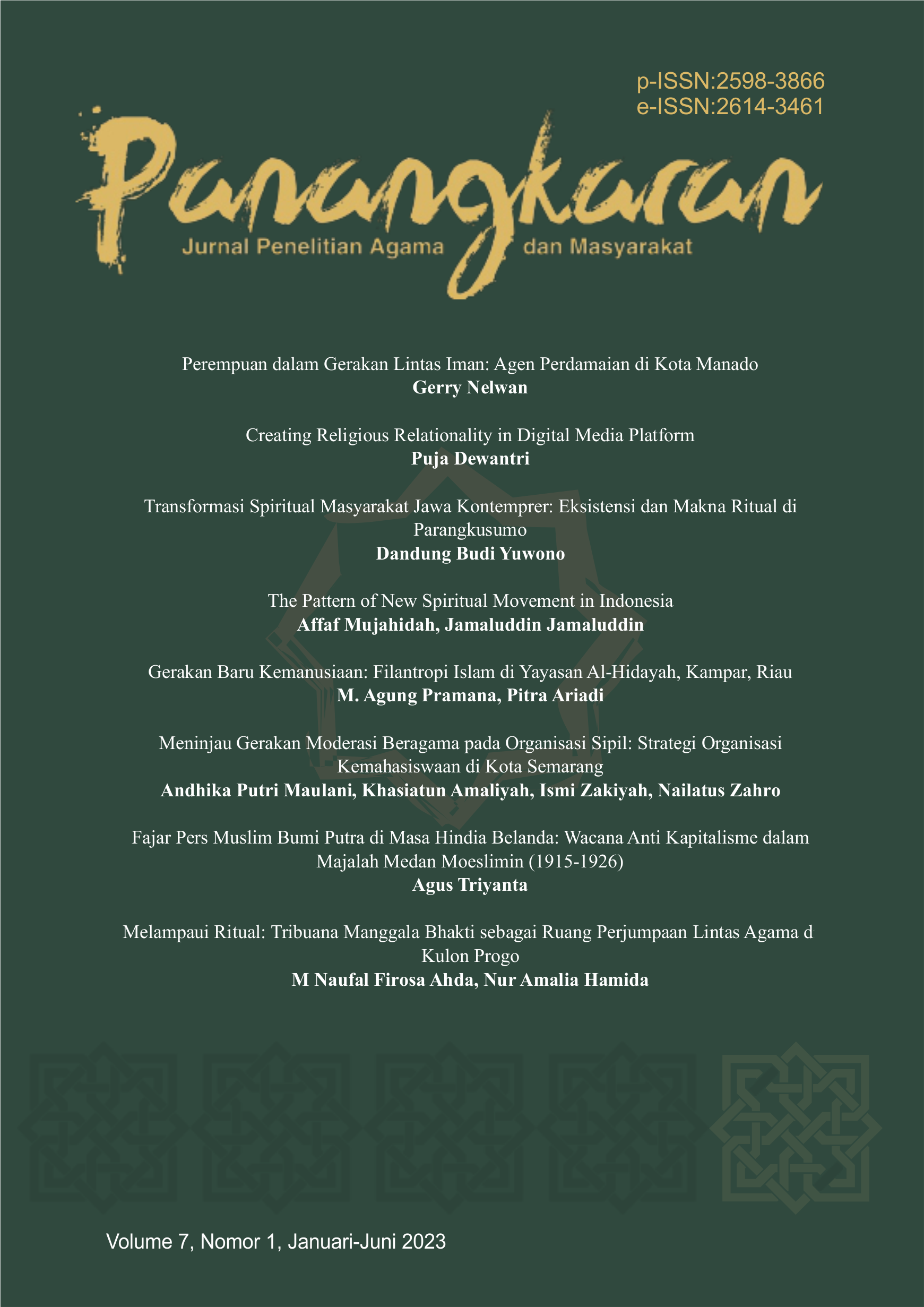Creating Religious Relationality in Digital Media Platform
DOI:
https://doi.org/10.14421/panangkaran.v7i1.3135Keywords:
Religiosity, Digital Media, RelationalityAbstract
Today's digital era has manifested a massive movement of people from an old society to a new society. This digital world has also changed the way people see and practise religion. Here, at least two questions are asked. First, consider how the use and accessibility of digital media affect religious knowledge and practise in order to raise religious awareness. The second question is how religion can be both a social practise and a discourse so that more people can participate in the discussion. This research aims to answer these two questions by adopting the indigenous religion paradigm which based on relationality. Indirectly, the main objective of this research is to figure out the interactions related to religious content in digital media as an up-to-date portrait of how religiosity is understood using the alternative of the religious paradigm as the embodiment of new topics in religious studies and the digital world: religious relationality paradigm. Through the three principles of the paradigm—responsibility, ethics, and reciprocity—digital media has helped to create distinctive religious awareness.
[Era digital saat ini telah mewujudkan perpindahan masyarakat secara masif dari masyarakat lama ke masyarakat baru. Dunia digital ini juga telah mengubah perspektif dan praktik seseorang dalam kehidupan beragama. Karenannya, dalam artikel ini, setidaknya terdapat dua pertanyaan yang diajukan. Pertama, bagaimana penggunaan dan aksesibilitas media digital memengaruhi pengetahuan dan praktik keagamaan untuk meningkatkan kesadaran beragama. Pertanyaan kedua adalah bagaimana agama dapat menjadi praktik sosial sekaligus wacana sehingga lebih banyak orang dapat berpartisipasi dalam diskusi keagamaan. Penelitian ini bertujuan untuk menjawab kedua pertanyaan tersebut dengan mengadopsi paradigma agama lokal yang berbasis relasionalitas. Secara tidak langsung tujuan utama dari penelitian ini adalah untuk mengetahui interaksi terkait konten keagamaan dalam media digital sebagai potret terkini bagaimana religiusitas dipahami dengan menggunakan alternatif paradigma keagamaan sebagai pengejawantahan topik baru dalam kajian agama dan dunia digital: paradigma relasionalitas agama. Melalui tiga prinsip paradigma—tanggung jawab, etika, dan timbal balik—media digital telah membantu menciptakan kesadaran beragama yang khas.]
Downloads
References
Abdullah, I. (2017). Di Bawah Bayang-bayang Media: Kodifikasi, Divergensi, dan Kooptasi Agama di Era Internet. Sabda, 12(2), 116–121.
Aldrich, D. P., & Meyer, M. A. (2015). Social Capital and Community Resilience. American Behavioral Scientist, 59(2), 254–269. https://doi.org/10.1177/0002764214550299
Amirudin, N., Sya’bani, M. A. Y., Supriyatno, T., & Susilawati, S. (2020). Strengthening the Existence of Islamic Education in the Industrial Revolution Era 4.0. Asian Journal of Applied Sciences, 8(6), 328–334. https://doi.org/10.24203/ajas.v8i6.6446
Andy Corry Wardhani, F. H. U. (2013). Teori Komunikasi Massa. Ghalia Indonesia.
Bregman, S. (2012). Uses of social media in public transportation. Transportation Research Board.
Briandana, R., Doktoralina, C. M., Hassan, S. A., & Hasan, W. N. W. (2020). Da’wah communication and social media: The interpretation of millennials in Southeast Asia. International Journal of Economics and Business Administration, 8(1), 216–226. https://doi.org/10.35808/ijeba/543
Broadbent, E., Gougoulis, J., Lui, N., Pota, V., & Simons, J. (2017). Generation Z: Global citizenship survey: The Varkey Foundation. https://www.varkeyfoundation.org/media/4487/global-young-people-report-single-pages-new.pdf
Burroughs, B., & Feller, G. (2015). Religious Memetics. Journal of Communication Inquiry, 39(4), 357–377. https://doi.org/10.1177/0196859915603096
Campbell, H. A., & Tsuria, R. (2021). Digital Religion. In Digital Religion. Routledge. https://doi.org/10.4324/9780429295683
Cox., J. L. (2007). From Primitive to Indigenous. Ashgate. https://doi.org/10.1093/jaarel/lfn081
Fenton, A., & Procter, C., (2019). Studying social media communities: Blending methods with netnography. In Sage Research Methods Cases Part 2. SAGE Publications, Ltd., https://doi.org/10.4135/9781526468901
Ferrissa, W. (2017). 10 Fakta dari Google tentang Populasi Digital di Indonesia dan Dunia. Kementrian Komunikasi Dan Informatika Republik Indonesia. https://www.kominfo.go.id/content/detail/12148/10-fakta-dari-google-tentang-populasi-digital-di-indonesia-dan-dunia/0/sorotan_media
Griffiths, M. D., Kuss, D. J., & Demetrovics, Z. (2014). Social networking addiction: An overview of preliminary findings. , . In Behavioral addictions (pp. 119–141).
Harahap, M. A. (2013). Kapitalisme Media: Ekonomi Politik Berita dan Diskursus Televisi. Aura Pustaka.
Hedman, U., & Djerf-Pierre, M. (2013). The social journalist: Embracing the social media life or creating a new digital divide? Digital Journalism, 1(3), 368–385. https://doi.org/10.1080/21670811.2013.776804
Hjarvard, S. (2011). The Mediatitation of Religion: Theorising Religion, Media and Social Change. Culture and Religion, 12(2), 119–135.
Hutchings, T. (2015). Christianity and digital media. In The changing world religion map (pp. 3811–3830). Springer.
Kucukcan, T. (2005). Multidimensional Approach to Religion: A Way of Looking at Religious Phenomena. Journal for the Study of Religions and Ideologies, 4(10), 60–70.
Maarif, S. (2019). Indigenous Religion Paradigm : Studies in Philosophy, 44, 1–20.
Masuzawa, T. (2005). The Invention of World Religions. In Method and Theory in the Study of Religion (Vol. 20, Issue 2). University of Chicago. https://doi.org/10.1163/157006808X283525
Muttaqin, Z. (2020). The Ngaji Online: Transforming Islamic Learning for Moslem Communities in the Digital Age. https://doi.org/10.4108/eai.1-10-2019.2291734
Safdar, G., & Khan, A. W. (2020). Digital Media Use and Religious, Moral and Cultural Effects on Female University Students of Punjab, Pakistan. Research Journal ‘Ulūm-e-Islāmia, 27(1), 113–129.
Setianto, W. A. (2019). Literasi Konten Radikal di Media Online. Jurnal Ilmu Komunikasi, 16(1), 75. https://doi.org/10.31315/jik.v16i1.2684
Stansberry, B. Y. K., Anderson, J., & Rainie, L. (2019). Experts Optimistic About the Next 50 Years of Digital Life.
Straubhaar, J., LaRose, R., & Davenport, L. (2015). Media now: Understanding media, culture, and technology. Cengage Learning.
Sullivan, S. C. (2012). Living faith: Everyday religion and mothers in poverty. University of Chicago Press.
Suyadi, Nuryana, Z., & Fauzi, N. A. F. (2020). The fiqh of disaster: The mitigation of Covid-19 in the perspective of Islamic education-neuroscience. International Journal of Disaster Risk Reduction, 51, 101848. https://doi.org/10.1016/j.ijdrr.2020.101848
Toffler, A. (1980). The third wave: The classic study of tomorrow. Bantam.
Van Dijck, J. (2013). The culture of connectivity: A critical history of social media. Oxford University Press.
Wikanda, F. (2017). Komunikasi Media Massa dalam Al-Qur’an dalam. Jurnal Pengembangan Masyarakat, 4(4).
Zickuhr, K., & Madden, M. (2012). Older adults and internet use. PEW Internet and American Life Project.
Downloads
Published
How to Cite
Issue
Section
License
Copyright (c) 2023 Puja Dewantri

This work is licensed under a Creative Commons Attribution-NonCommercial-NoDerivatives 4.0 International License.
JURNAL PANANGKARAN disebarluaskan dengan lisensi Creative Commons Attribution-NonCommercial-NoDerrivatives 4.0 International License.
 Abstract Viewed = 249 times
|
Abstract Viewed = 249 times
|
 pdf downloaded = 285 times
pdf downloaded = 285 times












